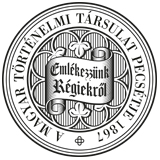Századok – 1994
Tanulmányok - Engel Pál: Magyarország és a török veszély Zsigmond korában (1387–1437) II/273
286 ENGEL PÁL 19 A tatai szerződésre és általában a magyar-szerb kapcsolatokra máig alapvető Radonió, J. Sporazum u Tati 1426 i srpsko-ugarski odnosi od XIII-XVI veka. Glas Srpske Kraljevske Akademije 187 (Beograd 1941) 117-232. 20 A német lovagrend szerepére Joachim, E. König Sigismund und der Deutsche Ritterorden in Ungarn 1429-1432. Mitteilungen des Instituts für österreichische Geschichtsforschung 33 (1911) 87-119. 21 A végvárak kiépítése Mályusz, Zsigm. 116, Engel, Ozorai 67 sk. Helyőrségeik tervezett létszámár és a várható költségekre, valamint az ígért bevételekre Joachim 109-112. Ennek alapján Mályusz Zsigm. 117 úgy vélte, hogy a költségek ténylegesen évi 314 822 forintot tettek ki. A szöveg azonban világosan utal arra, hogy ez csak a lovagok védelem- és költségtervezete volt, és ennyi pénzt sohasem kaphattak kézhez, vö. Engel P.: A magyar királyság jövedelmei Zsigmond korában, in. A tudomány szolgálatában. Emlékkönyv Benda Kálmán 80. születésnapjára. Szerk. Glatz F. Bp., 1993. 28. A tervezettnek mintegy harmadára rúgó tényleges költségek hozzávetőleg felbecsülhetők abból a másik lajstromból, amely a várőrségek tényleges létszámáról készült, és 1429-re datálható, Joachim 108 sk. 22 Mályusz E., A négy Tallóci-fivér. Történelmi Szemle 23 (1980) 531-576. vö. uő. Zsigm. 126-132., és Engel P. Királyi hatalom és arisztokrácia viszonya a Zsigmond-korban. Bp., 1977. 80, 203 sk. HUNGARY AND THE OTTOMAN THREAT IN THE AGE OF KING SIGISMUND (1378-1437) by Engel Pál (Summary) The article offers a summary of the Hungarian-TUrkish relations from the battle on the Kosovo Plain in 1389 to the death of King Sigismund. The author stresses the unique significance of the Ottoman conquest from the point of view of Hungarian foreign policy in the long run. It namely put an end to the Hungarian kingdom as a Great Power on the Balkans, a status enjoyed in the age of the Árpáds and the Anjous. From then on, Hungary was reduced to self-defence and the inherent loss of prestige caused problems of orientation among the leading elite of the country. The article attempts to give a novel interpretation to the Balkan policy of the Hungarian kingdom in the 15th century. The author maintains that after the defeat at Nicopolis in 1396 King Sigismund tried to make the neighbouring principalities on the Balkans into a kind of cordon sanitaire against the Ottoman threat This is what explains his grants of estates for the Balkan princes in Hungary and his campaigns against Bosnia in 1405-1410 when the tried to make the country part of his defence system. When his cordon sanitaire broke up in the 1420's, the king tried to make it up with a new type of defence policy. On the one hand he had a system of border castles built, and on the other he took Belgrade and built out a unified military administration in the Southern Province under the leadership of the brothers Tkllóci in the 1430's. Pál Engel LA HONGRIE ET LE DANGER TURC DANS L'ÉPOQUE DE ZSIGMOND (1378-1437) (Résumé) Létude résume la formation de la relation hongro-turque à partir de la bataille de Rigómező (1389) jusqu'à la mort de Zsigmond. Elle souligne l'importance unique de la conquête ottomane du point de vue de la politique extérieure hongroise de grande perspective. Elle voit cette importance dans le fait que le statut de grandes puissance du royaume hongrois qu'il a bénéficié dans les époques arpadiennes et dans l'époque des Anjou était supprimé sur les Balkans. La Hongrie devait avoir ensuite une position
